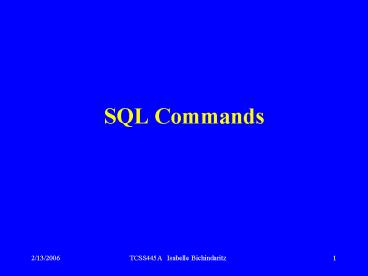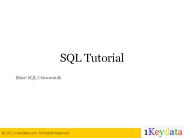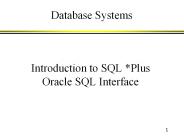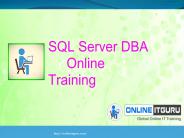SQL Commands - PowerPoint PPT Presentation
1 / 52
Title:
SQL Commands
Description:
ISO standard supports definition of FKs with FOREIGN KEY clause in CREATE and ALTER TABLE: ... INSERT/UPDATE that attempts to create FK value in child table ... – PowerPoint PPT presentation
Number of Views:114
Avg rating:3.0/5.0
Title: SQL Commands
1
SQL Commands
2
Learning Objectives
- Understand SQL commands
3
Acknowledgments
- These slides have been adapted from Thomas
Connolly and Carolyn Begg
4
ISO SQL Data Types
5
Integrity Enhancement Feature
- Consider five types of integrity constraints
- Required data.
- Domain constraints.
- Entity integrity.
- Referential integrity.
- Enterprise constraints.
6
Integrity Enhancement Feature
- Required Data
- position VARCHAR(10) NOT NULL
- Domain Constraints
- (a) CHECK
- sex CHAR NOT NULL
- CHECK (sex IN (M, F))
7
Integrity Enhancement Feature
- (b) CREATE DOMAIN
- CREATE DOMAIN DomainName AS dataType
- DEFAULT defaultOption
- CHECK (searchCondition)
- For example
- CREATE DOMAIN SexType AS CHAR
- CHECK (VALUE IN (M, F))
- sex SexType NOT NULL
8
Integrity Enhancement Feature
- searchCondition can involve a table lookup
- CREATE DOMAIN BranchNo AS CHAR(4)
- CHECK (VALUE IN (SELECT branchNo
- FROM Branch))
- Domains can be removed using DROP DOMAIN
- DROP DOMAIN DomainName
- RESTRICT CASCADE
9
IEF - Entity Integrity
- Primary key of a table must contain a unique,
non-null value for each row. - ISO standard supports FOREIGN KEY clause in
CREATE and ALTER TABLE statements - PRIMARY KEY(staffNo)
- PRIMARY KEY(clientNo, propertyNo)
- Can only have one PRIMARY KEY clause per table.
Can still ensure uniqueness for alternate keys
using UNIQUE - UNIQUE(telNo)
10
IEF - Referential Integrity
- FK is column or set of columns that links each
row in child table containing foreign FK to row
of parent table containing matching PK. - Referential integrity means that, if FK contains
a value, that value must refer to existing row in
parent table. - ISO standard supports definition of FKs with
FOREIGN KEY clause in CREATE and ALTER TABLE - FOREIGN KEY(branchNo) REFERENCES Branch
11
IEF - Referential Integrity
- Any INSERT/UPDATE that attempts to create FK
value in child table without matching candidate
key value in parent is rejected. - Action taken that attempts to update/delete a
candidate key value in parent table with matching
rows in child is dependent on referential action
specified using ON UPDATE and ON DELETE
subclauses - CASCADE - SET NULL
- SET DEFAULT - NO ACTION
12
IEF - Referential Integrity
- CASCADE Delete row from parent and delete
matching rows in child, and so on in cascading
manner. - SET NULL Delete row from parent and set FK
column(s) in child to NULL. Only valid if FK
columns are NOT NULL. - SET DEFAULT Delete row from parent and set each
component of FK in child to specified default.
Only valid if DEFAULT specified for FK columns - NO ACTION Reject delete from parent. Default.
13
IEF - Referential Integrity
- FOREIGN KEY (staffNo) REFERENCES Staff
ON DELETE SET NULL - FOREIGN KEY (ownerNo) REFERENCES Owner ON
UPDATE CASCADE
14
IEF - Enterprise Constraints
- Could use CHECK/UNIQUE in CREATE and ALTER TABLE.
- Also have
- CREATE ASSERTION AssertionName
- CHECK (searchCondition)
- which is very similar to the CHECK clause.
15
IEF - Enterprise Constraints
- CREATE ASSERTION StaffNotHandlingTooMuch
- CHECK (NOT EXISTS (SELECT staffNo
- FROM PropertyForRent
- GROUP BY staffNo
- HAVING COUNT() gt 100))
16
Data Definition
- SQL DDL allows database objects such as schemas,
domains, tables, views, and indexes to be created
and destroyed. - Main SQL DDL statements are
- CREATE SCHEMA DROP SCHEMA
- CREATE/ALTER DOMAIN DROP DOMAIN
- CREATE/ALTER TABLE DROP TABLE
- CREATE VIEW DROP VIEW
- Many DBMSs also provide
- CREATE INDEX DROP INDEX
17
Data Definition
- Relations and other database objects exist in an
environment. - Each environment contains one or more catalogs,
and each catalog consists of set of schemas. - Schema is named collection of related database
objects. - Objects in a schema can be tables, views,
domains, assertions, collations, translations,
and character sets. All have same owner.
18
CREATE SCHEMA
- CREATE SCHEMA Name
- AUTHORIZATION CreatorId
- DROP SCHEMA Name RESTRICT CASCADE
- With RESTRICT (default), schema must be empty or
operation fails. - With CASCADE, operation cascades to drop all
objects associated with schema in order defined
above. If any of these operations fail, DROP
SCHEMA fails.
19
CREATE TABLE
- CREATE TABLE TableName
- (colName dataType NOT NULL UNIQUE
- DEFAULT defaultOption
- CHECK searchCondition ,...
- PRIMARY KEY (listOfColumns),
- UNIQUE (listOfColumns), ,
- FOREIGN KEY (listOfFKColumns)
- REFERENCES ParentTableName (listOfCKColumns),
- ON UPDATE referentialAction
- ON DELETE referentialAction ,
- CHECK (searchCondition) , )
20
CREATE TABLE
- Creates a table with one or more columns of the
specified dataType. - With NOT NULL, system rejects any attempt to
insert a null in the column. - Can specify a DEFAULT value for the column.
- Primary keys should always be specified as NOT
NULL. - FOREIGN KEY clause specifies FK along with the
referential action
21
Example 1 - CREATE TABLE
- CREATE DOMAIN OwnerNumber AS VARCHAR(5)
- CHECK (VALUE IN (SELECT ownerNo FROM
PrivateOwner)) - CREATE DOMAIN StaffNumber AS VARCHAR(5)
- CHECK (VALUE IN (SELECT staffNo FROM Staff))
- CREATE DOMAIN PNumber AS VARCHAR(5)
- CREATE DOMAIN PRooms AS SMALLINT
- CHECK(VALUE BETWEEN 1 AND 15)
- CREATE DOMAIN PRent AS DECIMAL(6,2)
- CHECK(VALUE BETWEEN 0 AND 9999.99)
22
Example 1 - CREATE TABLE
- CREATE TABLE PropertyForRent (
- propertyNo PNumber NOT NULL, .
- rooms PRooms NOT NULL DEFAULT 4,
- rent PRent NOT NULL, DEFAULT 600,
- ownerNo OwnerNumber NOT NULL,
- staffNo StaffNumber
- Constraint StaffNotHandlingTooMuch .
- branchNo BranchNumber NOT NULL,
- PRIMARY KEY (propertyNo),
- FOREIGN KEY (staffNo) REFERENCES Staff
- ON DELETE SET NULL ON UPDATE CASCADE .)
23
ALTER TABLE
- Add a new column to a table.
- Drop a column from a table.
- Add a new table constraint.
- Drop a table constraint.
- Set a default for a column.
- Drop a default for a column.
24
Example 2(a) - ALTER TABLE
- Change Staff table by removing default of
Assistant for position column and setting
default for sex column to female (F). - ALTER TABLE Staff
- ALTER position DROP DEFAULT
- ALTER TABLE Staff
- ALTER sex SET DEFAULT F
25
Example 2(b) - ALTER TABLE
- Remove constraint from PropertyForRent that
staff not allowed to handle more than 100
properties at time. Add new column to Client
table. - ALTER TABLE PropertyForRent
- DROP CONSTRAINT StaffNotHandlingTooMuch
- ALTER TABLE Client
- ADD prefNoRooms PRooms
26
DROP TABLE
- DROP TABLE TableName RESTRICT CASCADE
- e.g. DROP TABLE PropertyForRent
- Removes named table and all rows within it.
- With RESTRICT, if any other objects depend for
their existence on continued existence of this
table, SQL does not allow request. - With CASCADE, SQL drops all dependent objects
(and objects dependent on these objects).
27
Views
- View
- Dynamic result of one or more relational
operations operating on base relations to produce
another relation. - Virtual relation that does not necessarily
actually exist in the database but is produced
upon request, at time of request.
28
Views
- Contents of a view are defined as a query on one
or more base relations. - With view resolution, any operations on view are
automatically translated into operations on
relations from which it is derived. - With view materialization, the view is stored as
a temporary table, which is maintained as the
underlying base tables are updated.
29
SQL - CREATE VIEW
- CREATE VIEW ViewName (newColumnName ,...)
- AS subselect
- WITH CASCADED LOCAL CHECK OPTION
- Can assign a name to each column in view.
- If list of column names is specified, it must
have same number of items as number of columns
produced by subselect. - If omitted, each column takes name of
corresponding column in subselect.
30
SQL - CREATE VIEW
- List must be specified if there is any ambiguity
in a column name. - The subselect is known as the defining query.
- WITH CHECK OPTION ensures that if a row fails to
satisfy WHERE clause of defining query, it is not
added to underlying base table. - Need SELECT privilege on all tables referenced in
subselect and USAGE privilege on any domains used
in referenced columns.
31
Example 3 - Create Horizontal View
- Create view so that manager at branch B003 can
only see details for staff who work in his or her
office. - CREATE VIEW Manager3Staff
- AS SELECT
- FROM Staff
- WHERE branchNo B003
32
Example 4 - Create Vertical View
- Create view of staff details at branch B003
excluding salaries. - CREATE VIEW Staff3
- AS SELECT staffNo, fName, lName, position, sex
- FROM Staff
- WHERE branchNo B003
33
Example 5 - Grouped and Joined Views
- Create view of staff who manage properties for
rent, including branch number they work at, staff
number, and number of properties they manage. - CREATE VIEW StaffPropCnt (branchNo,
staffNo, cnt) - AS SELECT s.branchNo, s.staffNo, COUNT()
- FROM Staff s, PropertyForRent p
- WHERE s.staffNo p.staffNo
- GROUP BY s.branchNo, s.staffNo
34
Example 3 - Grouped and Joined Views
35
SQL - DROP VIEW
- DROP VIEW ViewName RESTRICT CASCADE
- Causes definition of view to be deleted from
database. - For example
- DROP VIEW Manager3Staff
36
SQL - DROP VIEW
- With CASCADE, all related dependent objects are
deleted i.e. any views defined on view being
dropped. - With RESTRICT (default), if any other objects
depend for their existence on continued existence
of view being dropped, command is rejected.
37
Advantages of Views
- Data independence
- Currency
- Improved security
- Reduced complexity
- Convenience
- Customization
- Data integrity
38
Disadvantages of Views
- Update restriction
- Structure restriction
- Performance
39
Transactions
- SQL defines transaction model based on COMMIT and
ROLLBACK. - Transaction is logical unit of work with one or
more SQL statements guaranteed to be atomic with
respect to recovery. - An SQL transaction automatically begins with a
transaction-initiating SQL statement (e.g.,
SELECT, INSERT). - Changes made by transaction are not visible to
other concurrently executing transactions until
transaction completes.
40
Transactions
- Transaction can complete in one of four ways
- - COMMIT ends transaction successfully, making
changes permanent. - - ROLLBACK aborts transaction, backing out any
changes made by transaction. - - For programmatic SQL, successful program
termination ends final transaction successfully,
even if COMMIT has not been executed. - - For programmatic SQL, abnormal program end
aborts transaction.
41
Transactions
- New transaction starts with next
transaction-initiating statement. - SQL transactions cannot be nested.
- SET TRANSACTION configures transaction
- SET TRANSACTION
- READ ONLY READ WRITE
- ISOLATION LEVEL READ UNCOMMITTED
- READ COMMITTEDREPEATABLE READ SERIALIZABLE
42
Access Control - Authorization Identifiers and
Ownership
- Authorization identifier is normal SQL identifier
used to establish identity of a user. Usually has
an associated password. - Used to determine which objects user may
reference and what operations may be performed on
those objects. - Each object created in SQL has an owner, as
defined in AUTHORIZATION clause of schema to
which object belongs. - Owner is only person who may know about it.
43
Privileges
- Actions user permitted to carry out on given base
table or view - SELECT Retrieve data from a table.
- INSERT Insert new rows into a table.
- UPDATE Modify rows of data in a table.
- DELETE Delete rows of data from a table.
- REFERENCES Reference columns of named table in
integrity constraints. - USAGE Use domains, collations, character sets,
and translations.
44
Privileges
- Can restrict INSERT/UPDATE/REFERENCES to named
columns. - Owner of table must grant other users the
necessary privileges using GRANT statement. - To create view, user must have SELECT privilege
on all tables that make up view and REFERENCES
privilege on the named columns.
45
GRANT
- GRANT PrivilegeList ALL PRIVILEGES
- ON ObjectName
- TO AuthorizationIdList PUBLIC
- WITH GRANT OPTION
- PrivilegeList consists of one or more of above
privileges separated by commas. - ALL PRIVILEGES grants all privileges to a user.
46
GRANT
- PUBLIC allows access to be granted to all present
and future authorized users. - ObjectName can be a base table, view, domain,
character set, collation or translation. - WITH GRANT OPTION allows privileges to be passed
on.
47
Example 7/8 - GRANT
- Give Manager full privileges to Staff table.
- GRANT ALL PRIVILEGES
- ON Staff
- TO Manager WITH GRANT OPTION
- Give users Personnel and Director SELECT and
UPDATE on column salary of Staff. - GRANT SELECT, UPDATE (salary)
- ON Staff
- TO Personnel, Director
48
Example 9 - GRANT Specific Privileges to PUBLIC
- Give all users SELECT on Branch table.
- GRANT SELECT
- ON Branch
- TO PUBLIC
49
REVOKE
- REVOKE takes away privileges granted with GRANT.
- REVOKE GRANT OPTION FOR
- PrivilegeList ALL PRIVILEGES
- ON ObjectName
- FROM AuthorizationIdList PUBLIC
- RESTRICT CASCADE
- ALL PRIVILEGES refers to all privileges granted
to a user by user revoking privileges.
50
REVOKE
- GRANT OPTION FOR allows privileges passed on via
WITH GRANT OPTION of GRANT to be revoked
separately from the privileges themselves. - REVOKE fails if it results in an abandoned
object, such as a view, unless the CASCADE
keyword has been specified. - Privileges granted to this user by other users
are not affected.
51
REVOKE
52
Example 10/11 - REVOKE Specific Privileges
- Revoke privilege SELECT on Branch table from all
users. - REVOKE SELECT
- ON Branch
- FROM PUBLIC
- Revoke all privileges given to Director on Staff
table. - REVOKE ALL PRIVILEGES
- ON Staff
- FROM Director































